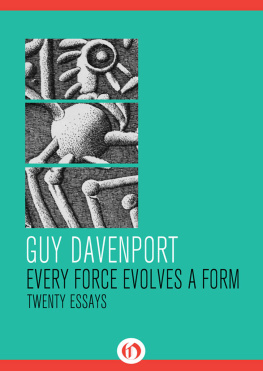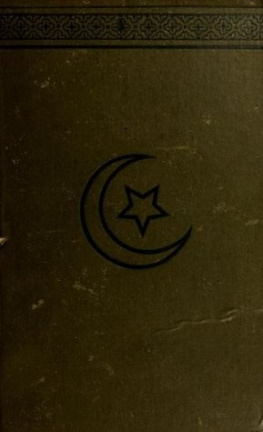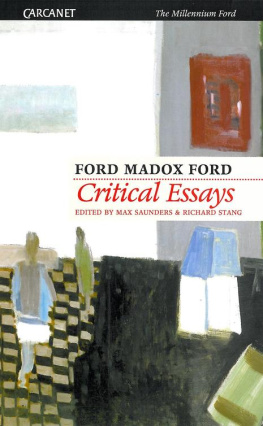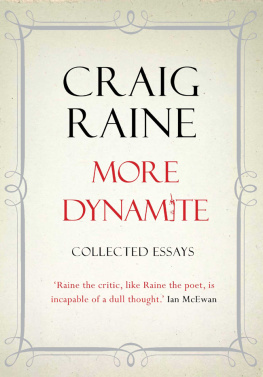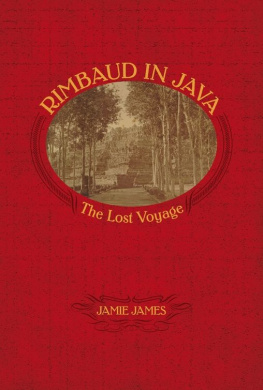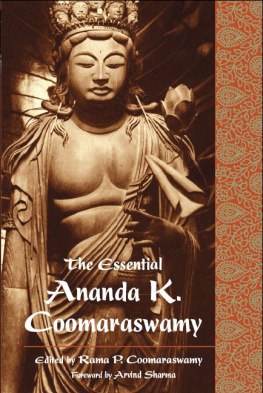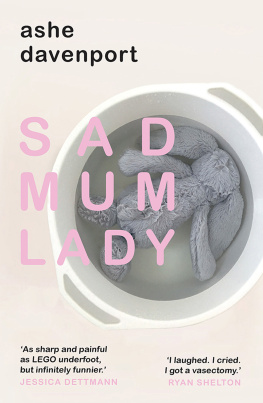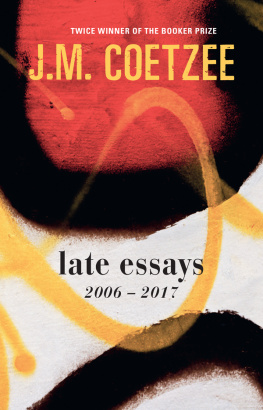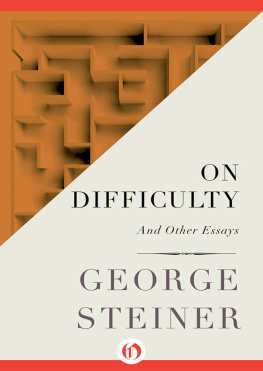Every Force Evolves a Form
Twenty Essays
Guy Davenport

For Rodney Needham

[The Celtic smith who cut the die for this silver coin was trying to make iconographic sense of others derived from a stater of Philip II of Macedonia, which bore a head of Hermes on one side and a winged horse on the other. Copy after copy, over centuries, provincial mints in Aquitania had already misread the face of Hermes as a lions head, as sun and moon, or as so many abstract lines and dots. Here Hermes profile has become the head and forelegs of a horse, his hair and neck its rump and wing. Horse has been an Aquitanian sign from Lascaux to the midyear centaurs who still dance as what the English call the Hobby Horse, on out to the bull ring horses of Goya (drawn in Bordeaux), the quagga-mounted utopian hordes of Fourier, and the St.-Simoniste horses of Rosa Bonheur. All art is a dance of meaning from form to form].
Contents
Foreword
I fancy mankind may come, in time, to write all
aphoristically, except in narrative; grow weary
of preparation, and connection, and illustration,
and all those arts by which a big book is made.
SAMUEL JOHNSON
(in Boswells The journal of a Tour of the Hebrides)
My title, which sounds like Heraclitus or Darwin, is from Mother Ann Lee (17361784), founder of the Shakers. In its practical sense, this axiom was the rule by which Shaker architects and designers found perfect forms. The American broom is a Shaker invention: a flat brush of sedge stems, sturdily bound, and with a long handle. Previously the broom, such as Parisian street-cleaners still use, was a fascicle of twigs, which one stoops to use. The Shaker broom sweeps. Ones upright stance in using it has dignity. It is a broom that means business. We are told that Mother Ann, overseeing the high art of sweeping Shaker rooms (the first uncluttered, clear interior domestic space in a century of china-shop impediments) would shout, There is no dirt in heaven!
As an ideal, that form is the best response to the forces calling it into being has been the genius of good design in our time, as witness Gropius, Le Corbusier, Rietveldt, Mondriaan, Sheeler, Fuller. A work of art is a form that articulates forces, making them intelligible. These studies, most of which were written for editors, are all, one way or another, considerations of ideas and their realization, instigations, innovations, renovations; that is, of force and form.
The Champollion of Table Manners, Imaginary Americas, Making It Uglier to the Airport, and In That Awful Civil War were first published in The Hudson Review; Balthus and What Are Those Monkeys Doing? (under the title Rousseau), in Antaeus; Transcendental Satyr (under the title Satyr and Transcendentalist), in Parnassus; The Smith of Smiths, More Genteel than God, and The Peales and Their Museum, in Inquiry. Montaigne is reprinted from Montaignes Travel Journal, translated by Donald M. Frame (North Point Press, 1983), Herondas from The Mimes of Herondas, my translation (Grey Fox Press, 1981), and Nabokovs Don Quixote from The New York Times Book Review and Vladimir Nabokov, Lectures on Don Quixote, edited by Fredson Bowers (Harcourt Brace Jovanovich, 1983). Late Beckett appeared in the Washington Post Book World, Pergolesis Dog in the New York Times. The Artist as Critic, The Scholar as Critic, and The Critic as Artist (a filched title) were read at Washington and Lee University as the Arthur and Margaret Glasgow Lectures for 1985 and published in Shenandoah. Ariadnes Dancing Floor was written for a collection of essays on Joyce that failed to materialize. Every Force Evolves a Form is an unabashedly experimental inclusion: it is simply a lecture, reconstructed from notes on a scrap of paper, for English 684 at the University of Kentucky. It was, like all my classroom lectures, invented on my half an hours daily walk to work. As all my ideas, such as they are, come from these walks, and from the classrooms at the end of them, it will perhaps interest a reader or two to see the raw matter of a class.
The Champollion of Table Manners
Table manners, we learn in Claude Lvi-Strauss ungivingly tedious book The Origin of Table Manners, are one of our subtlest lines separating civility from barbarity, an orderly barrier erected against chaos, and a set of gestured signals that began when the first two people to share a brained tapir trusted each other enough to eat together. Ungivingly tedious: the book is laughably mistitled. It is an analysis of several hundred Amazonian and Plains Indian myths, as well as a continuation of the elaborate structuralist theory of culture which began two volumes back with The Raw and the Cooked and From Honey to Ashes. Table manners are first mentioned on page 307. We do not see the phrase again until page 427. Not until page 471 do we leave the rain forest and prairie to hear an intense, brilliant, and brief discourse on what all that has gone before has to do with table manners.
Obliquity is the structuralist trademark. There is always something to be explained before something else can be explained. We begin with many versions of a myth about a clinging woman, The Hunter Monmanki and His Wives, from the Tucuna of South America. We dont know it yet, but the essence of the book is all here in this strange and apparently pointless tale. The hero gets a frog pregnant by pointing his penis at her, they marry, go hunting together, and straightway bump into the fact that they dine on wholly different things, and the hunters mother has a sharp word for a daughter-in-law who serves cockroaches as a delicacy. Our hero marries four more wives, with indifferent success. One of them breaks in half at the waist. When he tries to abandon her, the top half clings to his back and appropriates his food. Indian myths tend to be Bosch-like, nightmarish, strange.
Some fifty transmutations and variants of this myth later, we move to North America to hear another set. These also have to do with marrying frogs. Sun and Moon, looking down on the earth one day, decided to choose wives from the creatures below. Moon chose a maiden, but Sun, who did not like the squint on human faces when they looked at him, chose a frog. The mother of Sun and Moon was willing to be charmed by both her daughters-in-law, though Frog Wife came under suspicion immediately, because she peed at every hop. The test, however, was table manners. The wedding feast was a nice mess of buffalo chitterlings. The Indian wife crunched hers with a fine loud smacking noise and was much admired. Poor Frog Wife did not even know which was the food and which the fire beneath. She fished out a piece of charcoal, sucked on it, and let black spit run down her chin. This made everybody sick. Moon was derisive. Frog Wife jumped on his face and stayed there, like the clinging woman in the South American myth.
These tales, told over thousands of years around the campfire, display upon careful inspection and comparison something like a genetic code programmed with all the anxieties and intuition that have fed into it generation after generation. The myth of the clinging woman, for instance, contains a submerged pattern that has to do with the fishing seasons and the constellations that signal their beginning and end. It encodes a creation myth about the stars known as Berenices Hair. The twist of its plot is a message about marrying too close (incest) and too far off (incompatible

